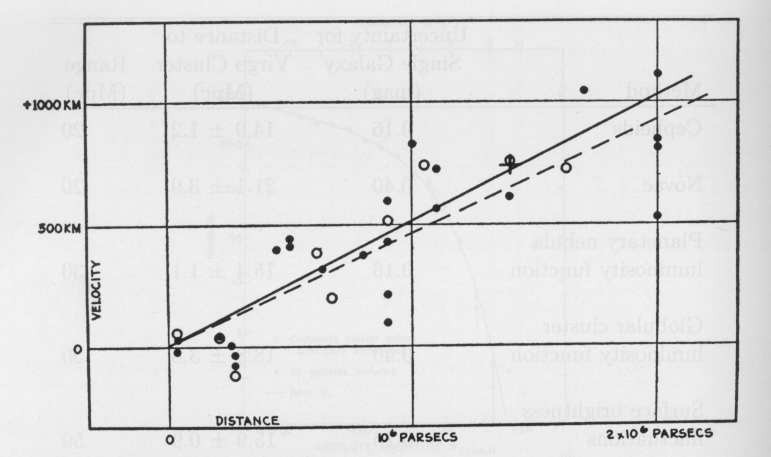
1917: Willem
de Sitter used general relativity to describe an expanding
universe.
Einstein favored a static model which neither expanded nor contracted,
by inserting an ad-hoc term he called the cosmological
constant.
1929: Hubble measures the expansion of the Universe

(Because of historic uncertainty in the Hubble constant, in the past, astronomers often defined a parameter h=H0/100, and write distance dependant results as (for example), d=200h-1 Mpc.)
Remember the redshift:

Using normal Doppler equation (v<<c), v=cz, and d=cz/H0.
But it is important to realize here that the cosmological redshift is not really due to galaxies moving through space at high velocities. Galaxies are actually "embedded" in space and space itself is expanding. The light emitted from the galaxies is "stretched" as it makes its way towards us, and we see it shifted to longer wavelengths.
Measuring distances in an expanding universe:
The distance between two objects can be defined as d = R(t) x r, whereFor two galaxies r only changes due to peculiar motion of the galaxies (ie due to gravity in a cluster, etc). The change in proper distance due to the expansion of space is entirely contained in R(t). We define R(now) = 1.
- d = proper distance
- R = dimensionless scale factor
- r = comoving coordinate
Note that on cosmological scales, this makes the distance between two objects an ambiguous concept. There are different ways of defining distances, which give different answers.

So if we observe a quasar at a redshift of z=3, at the time the light left the quasar, the universe was 1/4 its current size.
As z gets large, R gets small. At some point, R=0!
When did that happen?

Homer solves the age of the Universe.
Let's see. Space is expanding in such a way that d=v/H0, then to get to a distace d moving at velocity v would take time t0=d/v=1/H0. So the inverse of the Hubble constant is a (rough) measure of the age. This is called the Hubble time.If H0 = 72 (km/s)/Mpc, this is ~ 72 (pc/Myr)/Mpc, which is 72x10-6 Mpc/Myr/Mpc = 7.2x10-5 Myr-1.
Then t0 = 1/H0 = 1.39x104 Myr = 13.9 billion years.
There's a pretty big assumption built into this -- what is it?